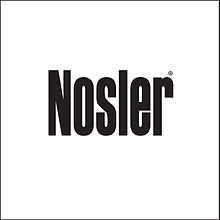- Nosler
-
Nosler Industry Ammunition Founded 1948 Founder(s) John A. Nosler Headquarters Bend, Oregon, US Area served Worldwide Products Ammunition, handloading components, Firearms, Safes Owner(s) Bob Nosler Divisions Nosler, Inc., Nosler Custom, Nosler Reloading Website http://www.nosler.com/ The name Nosler applies to a number of companies involved in the manufacture of ammunition and handloading components, specializing in high performance hollow point and soft point hunting bullets. Current companies include Nosler, Inc., Nosler Custom, and Nosler Reloading. Nosler's contributions include both new bullet designs and new manufacturing techniques used in their production.
Contents
Early history
John Nosler was born 4 April 1913 in Brawley, California. Nosler was hunting moose in British Columbia in 1946, when the bullets he was using failed to penetrate deeply enough to reach vital organs and kill the animal quickly.[1] At the time, most jacketed bullets employed a single copper alloy envelope (the jacket) around a single lead alloy core. The jacket on most military bullets was closed in front and opened at the base. These full metal jacket bullets offered good penetration, but often failed to expand and passed completely through an animal leaving a comparatively small wound. Soft-point hunting bullets like Nosler was using had the jacket applied in the opposite direction to completely cover the base, but open at the nose. These bullets would expand to leave a large wound channel, but sometimes broke into small pieces with inadequate momentum to overcome resistance of moving through bone or muscle tissue.
The experience inspired Nosler to develop a new bullet design, intended to expand readily at low impact velocities yet maintain integrity at high impact velocities (see terminal ballistics). These Nosler Partition bullets used a specially designed jacket enclosing two separate lead alloy cores.[1] The front core was open on the nose to expand easily, but expansion would stop at the partition (which was a solid layer of copper extending right across the bullet, not just the thin shell of copper which composed the jacket). The portion of the bullet behind the partition has the structural integrity of a full metal jacket bullet, but the expanded forward jacket leaves a larger wound channel. Bullets were originally manufactured for personal use, using hand made, lathe turned jackets. In 1948 Nosler began to sell the partition bullets commercially, forming Nosler, Inc.[2]
Further innovations by Nosler included new techniques of manufacturing bullet jackets that yielded more consistent expansion, better core bonding techniques to prevent separation of the lead core from the copper jacket, and the plastic Ballistic Tip used to provide the streamlined shape of a Spitzer boat tail, with the expansion of a hollow point.[1] The Nosler Ballistic Tip design has been copied by other manufacturers, such as the V-Max bullet by Hornady. John Nosler sold the production facilities to his son in 1988, and died at his home in Bend, Oregon, on 10 October 2010.[1]
Current company
Today, Nosler makes a number of different hunting bullets for rifle, handgun, and muzzle-loaders. They also manufacture brass and sell loaded ammunition, and Nosler Custom has recently begun to sell limited edition and semi-custom hunting rifles. The original Partition design bullet still is the company's flagship product. It has undergone many refinements over the years, but the basic design concept has remained unchanged.
Nolser experienced a massive explosion at their plant in Bend, Oregon on 2 June 2010. No one was harmed in the blast.[3]
References
- ^ a b c d Aaron Carter "John A. Nosler" American Rifleman January 2011 pp.38-39
- ^ "Partition". Nosler. http://www.nosler.com/Bullets/Partition.aspx. Retrieved 2010-12-23.
- ^ KOHD report on Nosler Explosion
External links
Categories:- Ammunition manufacturers
- Firearms manufacturers in the United States
- Hunting equipment
- Companies based in Bend, Oregon
- Privately held companies based in Oregon
Wikimedia Foundation. 2010.

